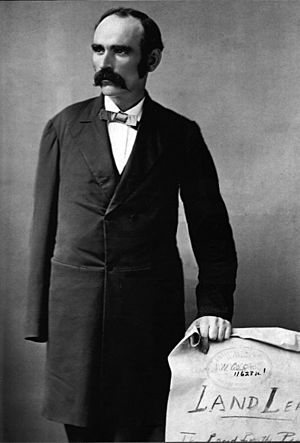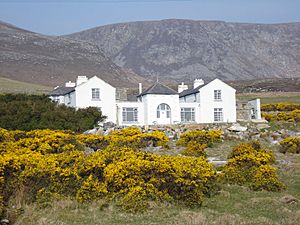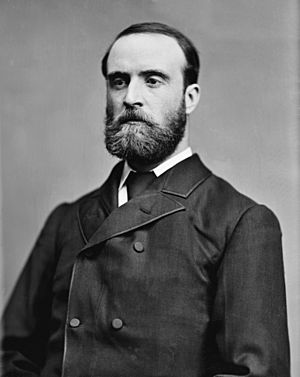Charles Boycott facts for kids
Quick facts for kids
Charles Boycott
|
|
|---|---|

Captain Boycott as caricatured by Spy (Leslie Ward) in Vanity Fair, January 1881
|
|
| Born |
Charles Cunningham Boycatt
12 March 1832 Burgh St Peter, Norfolk
|
| Died | 19 June 1897 (aged 65) Flixton, Suffolk
|
| Resting place | Burgh St Peter |
| Nationality | British |
| Occupation | Land agent, Farmer |
| Employer | John Crichton, 3rd Earl Erne, Hugh Adair |
| Opponent(s) | Irish National Land League |
| Spouse(s) | Anne Boycott (née Dunne) |
Charles Cunningham Boycott (born March 12, 1832 – died June 19, 1897) was an English land agent. A land agent was someone who managed land for a wealthy owner. Charles Boycott became famous because people in his local community in Ireland stopped working for him and refused to have anything to do with him. This led to the English language getting a new word: "boycott".
Boycott had been a soldier in the British Army and came to Ireland with his regiment. After leaving the army, he worked for Lord Erne, a rich landowner in County Mayo, Ireland.
In 1880, a group called the Irish National Land League was fighting for fairer rules for farmers. They wanted things like fair rent and the right to keep their land. When Lord Erne planned to evict some farmers, the Land League encouraged Boycott's workers to stop working for him. They also started a campaign to isolate Boycott. This meant that shops in nearby Ballinrobe refused to sell him food or supplies. Other services were also stopped. Some people were even threatened to make sure they followed these rules.
Boycott wrote a letter to The Times newspaper, and his story became very well known in Britain. Newspapers sent reporters to Ireland to write about what they saw as unfair treatment of Lord Erne's agent by Irish nationalists. To help Boycott, about 50 men from a group called the Orangemen traveled to Lord Erne's estate to harvest the crops. More than 1,000 police officers and soldiers were sent to protect them. This whole event cost the British government and others a lot of money, about £10,000, just to harvest crops worth about £500.
Charles Boycott left Ireland on December 1, 1880. Later, in 1886, he became a land agent for another estate in Suffolk, England. He died at his home in Flixton in 1897 when he was 65 years old.
Early Life and Family
Charles Cunningham Boycott was born in 1832. His parents were Reverend William Boycatt and Georgiana. He grew up in Burgh St Peter in Norfolk, England. His family had lived in Norfolk for nearly 150 years. They were originally Huguenots, a group of French Protestants who had to leave France in 1685.
Charles Boycott's family name was spelled "Boycatt" when he was born. They changed the spelling to "Boycott" in 1841.
Charles went to a boarding school in Blackheath, London. He was interested in the military. In 1848, he joined the Royal Military Academy, Woolwich, hoping to become an engineer in the army. However, he left the academy in 1849 after failing an exam. The next year, his family bought him a position in the 39th Foot regiment for £450.
Boycott's regiment moved to Belfast soon after he joined. Six months later, they went to Newry and then to Dublin. In 1852, Boycott married Anne Dunne in Dublin. He was sick for a while and sold his army position the next year. But he decided to stay in Ireland. He rented a farm in County Tipperary and became a small-scale landlord.
Life on Achill Island
After receiving some money from an inheritance, Boycott was convinced by his friend, Murray McGregor Blacker, to move to Achill Island. This is a large island off the coast of County Mayo. McGregor Blacker agreed to let Boycott use about 2,000 acres of land there. Boycott moved to Achill in 1854.
Life on the island was tough at first. But Boycott worked hard and eventually became successful. With more money from another inheritance and profits from his farming, he built a large house near Dooagh.
While on Achill, Boycott was involved in a few disagreements. For example, a local man named Thomas Clarke sued him for assault. Clarke said Boycott owed him money and had threatened him. But Clarke later took back his claims and said Boycott didn't owe him anything.
Boycott and McGregor Blacker also had a long dispute with Mr. Carr, who managed the Church Mission Estate, and his helper, Mr. O'Donnell. This argument started because Boycott and Carr supported different people in local elections, and Boycott's choices won. Carr was also in charge of collecting items from shipwrecks. In 1860, Carr accused Boycott of illegally taking things from a shipwreck. Boycott then sued Carr for saying false things about him.
The Lough Mask Affair
How the Land League Started

In the 1800s, farming was the biggest business in Ireland. A survey in 1876 found that almost all the land was owned by only 10,000 people. This was a tiny part of the population. Many of the richest landowners lived in Britain and hired agents like Charles Boycott to manage their estates.
Landlords usually divided their land into smaller farms and rented them to tenant farmers. These farmers often had short leases and could be forced off their land, even if they paid rent. Most farms were small, between 15 and 50 acres. Many small farmers also worked as laborers on bigger farms.
In the 1850s, some tenant farmers formed groups to demand "the three Fs":
- Fair rent: A reasonable price for renting land.
- Fixity of tenure: The right to stay on their land and not be easily evicted.
- Free sale: The right to sell their improvements to the land if they left.
Michael Davitt was the son of a small tenant farmer. He became a journalist and joined a group called the Irish Republican Brotherhood. He was put in prison, but Charles Stewart Parnell, a Member of Parliament, helped him get out. When Davitt returned home, he saw how farmers were trying to organize. He believed that helping farmers with their land problems was the best way to gain support for Irish independence.
In October 1879, Davitt formed the Irish National Land League. The Land League wanted to lower rents and stop evictions. In the long run, they wanted tenant farmers to own the land they farmed. Davitt asked Parnell to lead the league.
Parnell's Speech and Community Action
On September 19, 1880, Parnell gave a speech in Ennis, County Clare. He asked the crowd what they would do to a farmer who took over a farm after his neighbor was evicted. The crowd shouted, "kill him" or "shoot him." Parnell then explained that instead of violence, they should use social isolation. This meant treating the person like they didn't exist. This powerful method was first used against Charles Boycott.
The Land League was very active in the Lough Mask area. In September 1880, Lord Erne's tenants were supposed to pay their rents. He had agreed to lower the rent by 10% because of a bad harvest. But almost all his tenants wanted a 25% reduction. Boycott said Lord Erne refused this. So, Boycott started the process to evict eleven tenants.
Three days after Parnell's speech, a legal officer and 17 police officers tried to deliver Boycott's eviction notices. They managed to give notices to three tenants. But a fourth tenant, Mrs. Fitzmorris, refused the notice and waved a red flag. This warned other women in the area. They came and threw stones, mud, and manure at the officers, forcing them to run away to Boycott's house.
The next day, the officers tried again but failed. News spread to Ballinrobe. Many people went to Boycott's house and told his servants and laborers to leave their jobs immediately. Boycott said many of his servants were forced to leave because they were threatened. Soon, the local blacksmith, postman, and laundress also stopped serving Boycott. Boycott's nephew tried to deliver mail, but he was stopped and warned. Soon, shopkeepers in Ballinrobe refused to serve Boycott. He had to bring food and supplies by boat from Cong.
Newspaper Coverage and Saving the Crops
Before October 1880, few people outside County Mayo knew about Boycott's problems. But after he wrote a letter to The Times, a reporter named Bernard Becker traveled to Ireland. He interviewed Boycott and reported that Boycott had £500 worth of crops that would rot if no one helped harvest them. Becker wrote that no woman in Ballinrobe would wash Boycott's clothes or bake him bread. People said they were sorry, but they "dare not." Boycott had been advised to leave, but he said he couldn't abandon Lord Erne.
Becker's report was printed in other newspapers. Soon, newspapers started a fund to pay for people to go to County Mayo and save Boycott's crops. They raised £2,000.
In early November 1880, a "Boycott Relief Fund" was set up in Belfast. They planned an armed trip to Lough Mask. Many Irish nationalists saw this as an invasion. The Chief Secretary for Ireland, William Edward Forster, said he would not allow a large armed group. He said 50 unarmed men would be enough to harvest the crops, and the government would protect them.
On November 10, 1880, the relief group from Ulster left for County Mayo. Extra soldiers had already arrived to protect them. Boycott himself said he didn't need so many people because he had already saved most of the grain. He only needed a few laborers for other crops. He worried that bringing many Ulster Protestants into County Mayo could cause religious violence. The group faced angry protests on their way, but there was no violence. They harvested the crops without any problems.
What Happened Next
On November 27, 1880, Boycott, his family, and a local official were escorted from Lough Mask House by soldiers. No one would drive a carriage for them, so an army ambulance was used. They were taken to the train station, where Boycott and his family took a train to Dublin. In Dublin, he was not welcomed. The hotel he stayed in received letters saying it would be "boycotted" if Boycott remained. He had planned to stay a week, but he was advised to leave sooner. He left Dublin for England on December 1.
The government spent about £10,000 to harvest Boycott's crops. As Parnell said, this was "one shilling for every turnip dug from Boycott's land." Boycott himself said he lost £6,000 of his own money invested in the estate.
The idea of "boycotting" made the farmers more powerful. By the end of 1880, there were reports of boycotts all over Ireland. The events at Lough Mask also made the Land League and Parnell more popular.
In December 1880, Parnell and other Land League leaders were put on trial. They were accused of trying to stop people from paying rent. The trial attracted thousands of people. In January 1881, the judge ended the trial because the jury could not agree. Parnell and Davitt saw this as a victory.
After the boycotting, the Prime Minister, William Ewart Gladstone, started thinking about land reform. In December 1880, a group called the Bessborough Commission suggested major changes to land laws, including the "three Fs."
Eventually, a new law called the Land Law (Ireland) Act 1881 was passed. This law said that landlords and tenants shared ownership of the land. It also brought in the "three Fs." The act created the Irish Land Commission, which would set rents for 15 years and guarantee that tenants could keep their land. This law was very important for Ireland.
The Word "Boycott"
The word "to boycott" was first used by Father O'Malley in a conversation on September 23, 1880.
According to Joyce Marlow, the word first appeared in print in a newspaper called the Inter-Ocean on October 12, 1880. This was before Boycott's situation was widely known outside County Mayo. In November 1880, a newspaper in England called the Birmingham Daily Post mentioned the word as a local term. In 1888, the word was added to the first volume of the Oxford English Dictionary.
It seems there was no other word in English to describe this kind of social protest. The word "boycott" also became part of other languages, like Dutch, French, German, Polish, and Russian.
Later Life
After leaving Ireland, Charles Boycott and his family visited the United States. His arrival in New York caused a lot of media attention. The New York Tribune said that "The arrival of Captain Boycott, who has involuntarily added a new word to the language, is an event of something like international interest." Boycott traveled secretly under a different name. He went to visit friends in Virginia. After a few months, he returned to England.
In 1886, Boycott became a land agent for another estate in Suffolk, England. He loved horses and racing and became the secretary of the Bungay race committee. Boycott continued to spend holidays in Ireland. It seems he left Ireland without any hard feelings.
In early 1897, Boycott's health became very poor. To try and get better, he and his wife went on a cruise to Malta. But in Brindisi, he became very ill and had to return to England. His health continued to get worse, and he died on June 19, 1897, at his home in Flixton. He was 65 years old. His funeral and burial took place at the church in Burgh St Peter, where his nephew led the service. After his death, Boycott's wife, Annie, had to sell some of their belongings to pay for funeral costs and other debts. Several London newspapers published articles about his death.
Images for kids
-
St Mary's church at Burgh St Peter in Norfolk, where Boycott's father William Boycott was vicar, and where Charles Boycott is buried
-
Michael Davitt by Napoleon Sarony 1882
See also
 In Spanish: Charles Cunningham Boycott para niños
In Spanish: Charles Cunningham Boycott para niños









